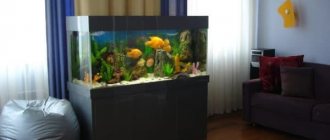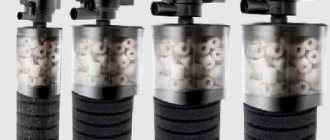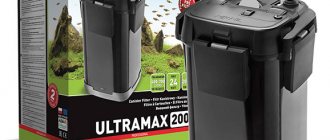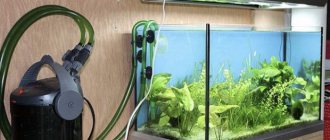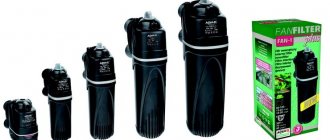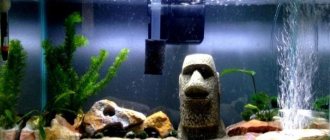Bottom filters are a simple water purification system that can be used in containers of various sizes. Cleaning is carried out naturally - using soil.
True, it also has a drawback - contaminants accumulate on the surface of the filter material, and it needs to be washed from time to time.
The design of such a device consists of the following components:
- water pump,
- lattice with small cells,
- tube systems.
Tubes are placed at the bottom of the container, a grate is installed on top, and then a layer of soil. It is worth remembering that fine soil or sand will not work, as they will clog into the mesh holes. Instead, use small stones or pebbles.
Pros and cons of bottom filters
Experienced and novice aquarists use such cleaning systems to complete containers of various sizes and volumes. Is it really worth choosing such a filtration system?
pros
- The water circulates constantly.
- The liquid never stagnate at the bottom of the aquarium, since it also penetrates through the soil.
- The container gets dirty more slowly. Therefore, the likelihood of harmful microorganisms and infections appearing is reduced.
With the help of a bottom filter system, the root system and soil are saturated with oxygen. But it is turned off periodically to eliminate excess. A constantly running filter helps reduce nutrients that are necessary for the development of shade plants and algae. Therefore, you should not use such a filter for a round aquarium with a huge amount of greenery.
Flaws
In order to install such a system, decorative elements, driftwood, substrate, and fish are removed from the aquarium. This will take a lot of time.
It is problematic to remove organic residues and dirt particles from the substrate using a bottom filter. After all, large elements settle in the tube. Therefore, they need to be washed quite often.
Large aquariums require an additional filter through which the entire volume of water will pass. Some aquarists use siphons, with the help of which large organic matter is removed from the liquid.
Experts recommend using a siphon every 7–10 days.
In order to ensure normal operation of the bottom filter, the tubes are periodically removed from the aquarium. They are cleaned of dirt and small stones.
Due to all of the above disadvantages, such cleaning systems are used to complete aquariums whose volume reaches 45–50 liters.
Popular manufacturers
Long gone are the days when aquariums were cleaned with a glass tube and hose. Modern aquarists have the opportunity to choose equipment for a small underwater kingdom. They are produced by well-known global companies.
Top most famous brands:
- Eheim produces filtering equipment for aquariums of all sizes and configurations, from 20-liter to containers with a capacity of one and a half tons. This brand's line includes high-tech external devices that will quickly clean the aquarium of debris and harmful impurities. Made from the best materials, the structures are designed according to precise calculations. Reliable operation and long service life are a common feature of Eheim products.
- Tetra is an extremely popular company that produces a range of products for purifying aquarium water and maintaining the microflora necessary for the health of fish. Innovative technology allows you to reliably remove harmful substances, ensuring a safe aquatic environment. The equipment works silently.
- Jebo makes excellent machines with the necessary options for effective filtration. External devices are easy to install, quiet in operation and easy to maintain. The Jebo canister filter is in demand, which is installed on marine and freshwater aquariums. The superbly designed system incorporates biological and mechanical filtration methods. The rotor and motor have a long service life. The plastic used in the manufacture of devices is environmentally friendly.
- Aquael produces the famous FAN series. These are the best aquarium filters for a beginner aquarist. Easy to install. All modifications provide reliable water purification in freshwater aquariums. The flow force is smoothly adjusted with a special handle. Aquael equipment is traditionally equipped with various useful accessories.
- JBL is one of the best companies producing special equipment for aquariums. Aquarium accessories of this brand belong to innovative products of this class. Multifunctional and extremely useful. The aeration system additionally saturates the water with oxygen. The equipment of this brand uses energy economically and is suitable for continuous operation.
The elegant shapes of filter devices from well-known brands will fit perfectly into any aquarium and ensure effective water cleaning.
Design features
The following elements are used to prepare aquarium bottom filters:
- Water pump.
- Several tubes.
- Grids or plates that include small cells.
Tubes are placed at the bottom of the tank. Plates with holes or gratings are placed on them. For stability, the plates are sprinkled with the selected substrate. You should not sprinkle the bottom filters with fine soil, fine-grained sand. After all, the substrate will penetrate into the holes and fill them. As a result, the filter in the aquarium stops functioning.
To increase stability, the gratings or plates are sprinkled with pebbles and small pebbles.
Principle of operation
The operating principle of a bottom-type cleaning device is:
- A pump located under the grate takes in water.
- Passing through the soil, the water is filtered, freeing itself from dirt and bacteria.
- The liquid returns to the reservoir.
The filter in the aquarium works using a natural method: nitrifying organisms living in the substrate process the remaining organic matter. When using a bottom-type device, the soil layer should be 4 cm or more.
Some aquarists improve the performance of the filter by equipping the device with an aerator, as a result of which both filtration and aeration are performed in the aquarium.
DIY bottom filter
To make a bottom filter for an aquarium with your own hands, various technologies are used. The simplest way is to use water pipes made of polymers or plastic that have the appropriate diameter (up to 25–30 cm).
Watch an interesting video about making a bottom filter with your own hands
Before determining the total length of the system, appropriate measurements of the tank are taken.
Certain elements are used to prepare the cleaning system. The list includes:
- Pipes – 3 pieces. The length of the plastic tubes must match the length of the container.
- Corners for subsequent connection - 4 pieces.
- Tee – 2 pieces.
- Pieces of plastic tubes - 4 pieces.
- Funnel for installing the filter component.
- Plastic separator.
Before making a bottom water intake system, a plate or grate is prepared. Ready-made gratings are sold in specialized stores. The plate is also prepared independently. For this, organic glass is used, in which holes are prepared using a soldering iron or drill.
A hole is prepared in the plate into which a pipe and pump are placed during installation. Pet stores sell pumps with the required characteristics.
For assembly, a standard scheme is used. The pump is placed in a pipe in which small holes are prepared. To provide traction, the number of holes on the other side increases. After this, the pipes are covered with a plate of organic glass or plastic.
The designed cleaning system is installed in the container after 2–4 hours.
Types
Depending on the direction of pumping water through the ground, direct and reverse filters are distinguished.
Straight
This is a classic design, which consists of a false bottom, bulk soil, a filter layer and a pump. Water through the soil and filter sheet is drawn under the false bottom and, already purified, is pumped back out.
Find out how to choose a filter for an aquarium, what to look for when choosing external and internal filters.
Cassettes used instead of filter sheets are in this case installed under the false bottom along with the pump. They cannot provide effective cleaning, since the water intake comes from the space between the false and real bottom. Large solid particles of waste are retained in the soil, and the aquarium gradually becomes polluted.
Back
This method is more effective due to the fact that the pump is installed in a cavity under the false bottom and pumps water in the opposite direction - from under the ground into the body of water.
Did you know? The world's smallest aquarium was made in Omsk by brothers-craftsmen named Konenko. Stanislav and Anatoly managed to create an aquarium with a volume of only 10 milliliters! This is not just a miniature toy, but a full-fledged ecosystem in which juvenile zebrafish live, aquarium plants are rooted, and the bottom is lined with decorative stones.
Small particles of sludge and waste rise from the bottom into the water column, are sucked into the filter cassette, cleaned and thrown into the aquarium. In this case, there is no stagnation of water and additional ascending aeration is carried out.
What cleaning systems should I use?
Some aquarists do not use bottom structures. To remove impurities they use internal and external devices.
External models are used to complete containers, both large-sized and small containers. They are complemented by compressors and other units. Their level of effectiveness is quite high.
Internal cleaning systems are installed in containers with a volume of 70 liters or more. They are equipped with various elements and accessories. This device works around the clock.
Bottom structures are advantageous for use because liquid purification is carried out naturally. Some aquarists do not use such products because they have certain disadvantages. Those people who have small containers with low walls will be able to evaluate their effectiveness.
Video about assembling the bottom filter and its operation
AdminAuthor of the article
Did you like the article?
Share with your friends:
Common mistakes
It often happens that you cannot assemble the filter yourself. If the unit does not fit tightly into the housing, then most likely the filtration baskets are overfilled or incorrectly placed. Sometimes the drainage holes are not aligned correctly. It happens that the rubber gaskets do not fit into their grooves.
The causes of filter leakage can be:
- The device head clamps are not tightly closed. This can happen due to the usual carelessness of the master. The human factor takes place in any field of activity. Fixing the problem is not difficult - just tighten the clamps more tightly.
- Gasket/seal contaminated. Of course, this will not happen in a newly assembled filter, but this happens in operating installations. The rubber seals must be cleaned of mucus and dirt, preferably lubricated with Vaseline or another substance. To avoid this problem, it is important to check the system status once a month.
- The gasket is not inserted correctly.
Nitrogen cycle
In order to effectively influence the living conditions of the aquarium inhabitants, it is necessary to have an understanding of the processes occurring in the aquarium and the filter.
The main water pollution occurs as a result of feeding the inhabitants of the aquarium. Moreover, it does not matter whether the food is completely eaten or its remains have fallen to the bottom. Uneaten food and metabolic products secreted by fish are the main suppliers of organic compounds participating in the cycle of biological transformations with the help of various microorganisms (nitrogen cycle).
Nitrogen cycle
The first stage of this cycle, called mineralization, consists of the utilization of complex nitrogen-containing organic compounds to simple inorganic ones. The result of the decomposition of animal waste products is ammonia NH3, which is dangerous for living organisms even at a concentration of 0.01 mg/l. Ammonia interacts with hydrogen ions H+ present in water, or with water molecules, to form ammonium ions NH4+, a less dangerous but also toxic substance.
The ratio of ammonia to ammonium depends on a number of factors. One of which is the active reaction of water (pH). At pH values below 7.0 units, the ammonia content in water is negligible. So, at a pH value of 7.0, the proportion of ammonium is 99.5%, and ammonia is 0.5%. At pH values greater than 7.0 units, the proportions are somewhat different. At pH = 7.5, the ammonium content is 96%, and ammonia - 4%, and at a pH value of 8.0, the proportion of ammonium will be 92%, and ammonia - 8%.
Water temperature can also affect the ratio of ammonia and ammonium, at the same pH value. At higher temperatures, the ammonia content in the water will be higher. And since most of the inhabitants of the aquarium come from warm tropical waters and, accordingly, the water temperature for keeping them lies in the range from 24 to 30 ° C, ammonia can become a significant problem.
The second stage of the nitrogen cycle is called nitrification; it is the process of biological oxidation of ammonia and ammonium ions, first to nitrites NO2, and then to nitrates NO3. These processes take place in an aerobic environment (i.e. rich in oxygen) under the influence of nitrifying bacteria present in the aquarium. The main role of the nitrification process is to convert highly toxic nitrogen compounds (ammonia, nitrite) into low-toxic compounds (nitrates).
Nitrates are also harmful to aquatic organisms, but their effect is much weaker than that of ammonia and nitrites. Nitrates are the end product of the nitrification process, since they are no longer broken down, but only accumulate in the water, negatively affecting fish. You can reduce the concentration of nitrates in the aquarium by replacing some of the old water with fresh water. Aquatic vegetation plays an important role in the absorption of nitrates.
Unlike nitrates, nitrites are poisonous even in small doses. Their maximum concentration should not exceed 0.1 mg/l. Since even a short stay in such water can cause damage to some internal organs of fish.
Filling options
The most common and affordable materials for filling an aquarium filter system are padding polyester and foam rubber. They are able to take any form and also act as mechanical and biological filters. The pores of these materials provide enough space for bacteria to spread. It is necessary to periodically rinse the filler to get rid of mucus that clogs the filter system. In addition, silt can settle in the pores, which should not be inside the filtration system, interfering with its operation. There are several options for filling external aquarium filters:
- Filter wool is a budget-friendly filler that is suitable for repeated use. It is easy to clean, with its help the filter space is filled quite tightly, which eliminates the possibility of leakage. It is the best option for use at the final stage of cleaning.
- Ceramic rings are used to uniformly distribute water flows, which ensure the transport of oxygen to the bacteria.
- Plastic bio-balls. Their movement in the water promotes uniform washing of all filter materials. It should be noted that this filler can be used as a substrate to support the vital activity of bacteria.
You can fill the aquarium with various materials
- Sintered glass. The most convenient option is to purchase the material in the form of balls. A special baking technology promotes the formation of pores in products. The latter contain beneficial microorganisms that process nitrites and nitrates. The efficiency of glass is significantly higher than that of other materials used for biological treatment.
- Ceramic tubes are used to breed bacteria in small pores.
- Zeolite is a low-cost, but very effective sorbent that quickly absorbs an element such as ammonium from water. With its help you can get rid of nitrates in the aquarium.
- Activated carbon. Many experts argue about the advisability of using this material for cleaning aquariums. Some people tend to think that it is better to use small granules for filters. It should be noted that they should have many pores, because this indicator affects the absorption efficiency. In addition, the quality of the material can be determined by the presence of characteristic shine and special dust. Before placing material into the filter system, it must be thoroughly rinsed.
- Peat is a natural material for filtration systems. It is affordable, successfully copes with many tasks - it reduces the Ph level, slows down the growth of fungi, and has a positive effect on the inhabitants of the aquarium.
All of the above fillers can be found on the shelves of pet stores.

